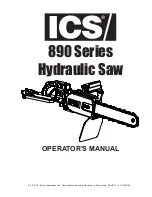
21
In the case of right bevel cut
Table (A)
006363
Table (B)
006364
Example:
In the case of cutting 52/38° type crown molding for position (1) in
Fig. 37 & 38
:
• Tilt and secure bevel angle setting to 33.9° RIGHT.
• Adjust and secure miter angle setting to 31.6° RIGHT.
• Lay crown molding with its broad back (hidden) surface down on the turn base with its WALL CONTACT EDGE
against the guide fence on the saw.
• The finished piece to be used will always be on the RIGHT side of the blade after the cut has been made.
7.
Wood facing (Fig. 39)
Use of wood facing helps to assure splinter-free cuts in
workpieces. Attach a wood facing to the guide fence
using the holes in the guide fence.
See the figure concerning the dimensions for a sug-
gested wood facing.
CAUTION:
• Use the straight wood of even thickness as the wood
facing.
WARNING:
•
Use screws to attach the wood facing to the guide
fence. The screws should be installed so that the
screw heads are below the surface of the wood fac-
ing so that they will not interfere with the position-
ing of the material being cut.
Misalignment of the
material being cut can case unexpected movement
during the cutting operation which may result in a loss
of control and serious personal injury.
NOTICE:
• When the wood facing is attached, do not turn the turn
base with the handle lowered. The blade and/or the
wood facing will be damaged.
8.
Cutting repetitive lengths (Fig. 40)
When cutting several pieces of stock to the same length,
ranging from 220 mm to 385 mm, use of the set plate
(optional accessory) will facilitate more efficient opera-
tion. Install the set plate on the holder (optional acces-
sory) as shown in the figure.
Align the cutting line on your workpiece with either the
left or right side of the groove in the kerf board, and while
holding the workpiece from moving, move the set plate
flush against the end of the workpiece. Then secure the
set plate with the screw. When the set plate is not used,
loosen the screw and turn the set plate out of the way.
NOTE:
• Use of the holder-rod assembly (optional accessory)
allows cutting repetitive lengths up to 2,200 mm
approximately.
9.
Groove cutting (Fig. 41)
A dado type cut can be made by proceeding as follows:
Adjust the lower limit position of the blade using the
adjusting screw and the stopper arm to limit the cutting
depth of the blade. Refer to “Stopper arm” section
described on previously.
After adjusting the lower limit position of the blade, cut
parallel grooves across the width of the workpiece using
a slide (push) cut as shown in the figure. Then remove
the workpiece material between the grooves with a
chisel.
Molding position
in Fig. 37 & 38
Bevel angle
Miter angle
52/38° type
45° type
52/38° type
45° type
For inside corner
(1)
Right 33.9°
Right 30°
Right 31.6°
Right 35.3°
(2)
Left 31.6°
Left 35.3°
For outside corner
(3)
(4)
Right 31.6°
Right 35.3°
Molding position
in Fig. 37 & 38
Molding edge against guide fence
Finished piece
For inside corner
(1)
Wall contact edge should be against
guide fence.
Finished piece will be on the Right
side of blade.
(2)
Ceiling contact edge should be
against guide fence.
For outside corner
(3)
Finished piece will be on the Left
side of blade.
(4)
Wall contact edge should be against
guide fence.
















































